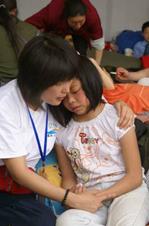International aid agency Save the Children has today called for a dramatic shake up in dealing with natural disasters linked to climate change.
The agency's latest report, In the Face of Disaster, says that governments, international organizations and aid agencies must change their tactics and prepare for natural disasters rather than just responding to them. They must invest now to prepare in advance for the increase in the number and severity of disasters that climate change will bring. It is too late to concentrate solely on reducing carbon emissions – climate change is already having an impact. Now is the time to plan for disasters before they happen to reduce the damage they cause to the lives of vulnerable children and their families.
|

|
|
Yang Xiaojuan is a fourth-grade student at Qiuxin Primary School in Beichuan County. She is much luckier than many other children affected by the quake as her parents, who worked faraway, returned and connected with her shortly after the disaster. |
It is estimated that every $1 spent on preparing for a disaster can prevent $7 of losses. If all the countries that give money to humanitarian assistance invested an additional 10 percent of the approximately $10 billion they spend on responding to disasters on preparation, they could prevent $7 billion of losses. It is enough to respond to five tsunamis.
Save the Children's Emergency Expert, Amelia Bookstein Kyazze said:"Climate change has moved the goal posts for responding to emergencies and we, as the international community, must adapt. Investing in preparing for disasters now will not only save millions of pounds in the long run – it will save lives. Now is the time to think big."
In a previous report in its climate change series published last year, Save the Children said that 50 percent of those affected by natural disasters were children and estimated that up to 175 million children every year are likely to be affected by the kinds of natural disasters brought about by climate change.
 |
|
Yu Xiaoyan was crying and nestled up to a psychological support volunteer. Since her mother is nowhere to be found, she has been depressed. The support of volunteers seems to be of little help. |
Bookstein Kyazze continued:"It is difficult to predict exactly when and where disasters will strike, but we know which countries are vulnerable and there are many ways that we can plan for disasters. We know the areas where disasters recur, like the flood-prone deltas of Bangladesh, the arid drought-affected Sahel region of West Africa, the volatile Pacific Rim. Instead of playing catch up with climate change and waiting for disaster to strike, the international community should invest now in projects that will reduce the devastating impact of the natural disasters that climate change will bring."
Recent events have highlighted the difference that investing in preparation can make. In Bangladesh in November 2007, thousands of volunteers that were part of the country's cyclone preparedness program mobilized to evacuate people living in the path of Cyclone Sidr. The rapid response was responsible for saving tens of thousands of lives – fewer than 4,000 people died in 2007, compared to 140,000 in a similar scale cyclone in 1991.
The projects that should be funded to prepare for disasters include things such as planting mangrove trees, building disaster resistant public buildings, making clear evacuation routes and setting up early warning systems. These projects, known as Disaster Risk Reduction, should involve everyone, including children living in villages, governments and international organizations.
 |
|
Oiao Sisi is a 7-year-old first-grade student at Renjiaping Primary School in Beichuan County. She is being taken care of by her grandmother. They were both taken to Mianyang and given temporary shelter after the quake. |
The Chinese government has made a great effort to mitigate climate change and has had many achievements over years. For instance, the government promotes technology development and improving energy efficiency. As a result, between 1991 and 2005, 800 million tons of energy were saved by economic restructuring and improved energy efficiency. Meanwhile, many tree-planting programs were carried out nationwide. Also, the government passed laws, regulations and policies, as well as established relevant institutions and groups, to help better the climate. Nevertheless, more policies and actions have recently been taken for further climactic improvement.
China's National Climate Change Program was issued on May 30, 2007. It outlines the objectives, principles, key areas and related measurements for the government until 2010.
An agreement, called the Hyogo Framework, was developed in 2005. 168 countries have already reached this on the need for disaster risk reduction work to take place at local, national, regional and international levels. However, Save the Children is concerned that those involved are yet to deliver on their commitments.
Save the Children recommends:
? Donors should commit the equivalent of an additional 10 percent of the money they currently spend on disaster response to preparing for disasters.
? The countries who adopted the Hyogo framework should make good on their commitments to it and report back on the progress they are making.
? Children who live in disaster-prone areas should be taught about how to respond to emergencies and should be involved in all levels of disaster risk reduction projects in their communities.
(China.org.cn July 1, 2008)